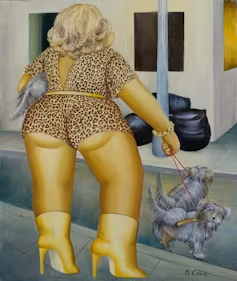by Mark Dennis
They are hung alternately, cheek to cheek, in a modest but thorough show at Studio Voltaire in London, two bodies of work that represent two seemingly disparate slices of 20th-century life.
A strange pair of bedfellows, one reveals a selection from the “dirty drawings” of leather grandaddy Touko Laaksonen (1920-1991) AKA Tom of Finland, and the other paintings by British B&B-landlady-turned-national-treasure, Beryl Cook (1926-2008). This pairing seems obvious only after the fact, but this exhibition demonstrates several important correspondences between the two artists.
Raunchy, lolzy, guilt-free pleasure permeates the show. The two artists reveal people engaging in earthly delights: drinking, dancing, flirting, stripping and all manner of sex acts with breezy, gay abandon. All of these activities are distilled through two very particular ways of selecting from and configuring the world.

Tom of Finland depicts fantastical hypermasculine beefcake bodies as vessels for leather – all bulges, boots and uniforms engaging in either furtive or vivid carnal excess.
This was born of formative experiences lusting after workmen as a teenager, and then when conscripted, cruising for soldiers during the blackouts of the second world war. This military world was then supplemented by other influences, such as 1950s motorcycle gang culture as exemplified by Marlon Brando in The Wild One (1953).
For Beryl Cook, her fetishes are equally specific: shoes, food, fat fingers, fags, make-up and flashy fashion. Strictly composed scenes of endless raucous revelry are dominated by monumental figures collaged out of these objects and attributes.https://loader.bridged.media/direct/index.html?website=https://theconversation.com&journeyId=65f0269195d8096d23e3804e
As the programme explains, the exhibition also aims to compare “the two artists’ distinct and coherent way of hyper-realising the body”. Whether in thongs, leopard print or tight leather, in this show at least, this formalised system of representation is overwhelmingly evidenced in exquisite depictions of the bum.
Lust, voyeurism and fun
Underlying all of this is the compulsive pleasure of voyeurism: in Tom’s case, lust and longing; in Beryl’s, fun and affection, but distanced. Both artists have equally run the gauntlet of various commentators trying to exclude them from the category of art, under charges of indecency or incompetency respectively. But the pairing in this show confidently renders those questions irrelevant; they help each other out.

Tom lends Beryl a serious, alternative and queer cultural context, while Beryl brings out the essential joy and wry humour in Tom’s work. Importantly, the show includes her depictions of the Lockyer Tavern in Plymouth and the Bang! club night (the precursor to London’s G-A-Y) – important social spaces for lesbians, gay men, sex workers and trans people.
The relationship is also emphasised by the curatorial choices, such as Tom’s muscle man crawling his way through a forest of jackboots, one lightly pressing down on his groin, counterpoised with Beryl’s pavement view of strappy leather shoes, leopard-print dress trims and pampered poodle paws.

There are three vitrines (glass display cabinets) in this show, contextualising the works on the wall in terms of their (re)production, distribution and reception. Treats include Beryl’s photo albums, opened at images of drag queens and slyly snapped bottoms peeking through the backs of chairs. These sit alongside her concise sketches, notably of women’s open-sided PVC trousers and fruit machines.
Style and substance
Tom of Finland initially became known through his own self-printed photographs, designed to evade customs, but reached a wider audience through publications such as Physique Pictorial, a men’s health magazine with coded gay erotic content. It is this distribution network that first introduced the work to a younger generation of gay artists such as the American photographer Robert Mapplethorpe.

Beryl’s work also became famous through calendars, greeting cards, book illustrations and affordable reproductions, which then began to decorate the working-class social spaces she depicted. Both artists had a close relationship with their fanbase, and the opening-night crowd for this show was a beautiful overlaying of the two audiences – a queer mix Beryl especially would have enjoyed.
The exhibition emphasises the cultural importance of these two figures, but what about their formal or visual qualities? Having previously experienced both artists exclusively through reproductions means that encountering their work in the flesh was weird, like bumping into a TV star in the street and noticing their wrinkles. In art terms it felt like the works re-acquired their aura as objects.

Both artists were self-taught. Beryl Cook admired modern British figurative painters of the previous generation, such as Stanley Spencer. But this show connects her work directly to the painter Edward Burra, who by many accounts was equally retiring, and offers a more convincing influence on Cook’s nightlife scenes.
On being shown reproductions of her paintings, Burra apparently loved them. However, Cook was always endearingly self-critical when it came to her technical ability.
Her work is in fact interesting to encounter close up. Smooth gradients and scratchy textures, caked on mascara and blobby hair in curlers all reveal the process in these hard-won pictures.

Tom of Finland’s draughtsmanship was developed independently and refined through his day job as an ad man, and his delicately rendered drawings were unexpectedly soft, light and dreamy.
This show works hard to reassess both artists outside of the usual criticisms and hang-ups. Beryl Cook and Tom of Finland together offer a shame-free, empowered utopian world, an alternative to the state-sponsored persecution and neglect suffered by women and queer people alike during both artists’ lifetimes.
This in turn reminds us that solidarity between women, queer and trans communities should be considered an old alliance against oppressive forces, and therefore cherished and preserved.



